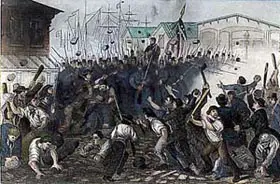Civil War Battles |
Colonial Wars |
American Wars |
Link To This Page — Contact Us —
The Baltimore Riots
April 19, 1861 in Baltimore, Maryland
The Baltimore Riot was also called the "Pratt Street Riot" and the "Pratt Street Massacre". It is regarded by historians as the first bloodshed of the Civil War.
 |
A clash between some pro-South civilians and Union troops in Baltimore resulted in what is commonly accepted to be the first bloodshed of the Civil War. Secessionist sympathy was strong in Baltimore, a border state metropolis.
Before Abraham Lincoln's inauguration, rumors in the city of an assassination plot against Lincoln, who was on his way to Washington, D.C., forced the him to sneak through Baltimore in the middle of the night. Anti-Union sentiments there only increased once the hostilities commenced at Fort Sumter on April 12.
On April 19, one of the first regiments to respond to Lincoln's call for troops, the 6th Massachusetts Regiment was travelling south to Washington, D.C. through Baltimore. At that time, there was no direct rail connection between the Philadelphia & Wilmington & Baltimore Railroad's President Street Station and the Baltimore & Ohio Railroad's Camden Station due to ordinances prohibiting the use of steam locomotives in the inner city. Rail cars that transfered between the two stations had to be pulled by horses along Pratt Street.
There had been talk of trouble from pro-secessionists in Baltimore for some days and the Federal government was faced not only with the defense of the capital, but with keeping touchy Maryland in the Union. Baltimore was the major eastern rail center near Washington and with it cut off, it could well be in danger.
An angry crowd of secessionists tried to keep the regiment from reaching Washington. As the regiment transfered between stations, the mob attacked the train cars and blocked the route. They were blocking several of the transports, breaking windows, hooting and jeering the troops. When it became apparent that they could travel by horse no further, the troops got out of the cars and marched in formation through the city. The mob followed in close pursuit, surrounded and jeered the regiment, then started throwing bricks and stones. Mayor George W. Brown said that there was not any notice of the coming of the Union troops was given to him or the police.
Panicked by the situation, several soldiers fired into the mob, and chaos immediately ensued as a giant brawl began between fleeing soldiers, the violent mob, and the Baltimore police who tried to suppress the violence. In the end, the soldiers got to the Camden Station, and the police were able to block the crowd from them. The regiment had left behind much of their equipment, including their marching band. The police managed to hold the crowd back at the terminal, allowing the soldiers to board their train and escape, leaving behind much of their equipment as well as their marching band.
After the rioting, some small skirmishes occurred throughout Baltimore between citizens and police for the next month, but a sense of normalcy returned as the city was cleaned up. Mayor George William Brown and Maryland Governor Thomas Hicks implored President Lincoln to reroute troops around Baltimore city and through Annapolis to avoid further confrontations. On the evening of April 20, Hicks also authorized Brown to dispatch the Maryland state militia for the purpose of disabling the railroad bridges into the city - an act he would later deny. One of the militia captains was John Merryman, who was arrested without a writ of habeas corpus one month later, sparking the case of "Ex parte Merryman."
Baltimore's mayor and police chief authorized the destruction of key rail bridges to prevent Union troops from entering the city. Secessionist groups, meanwhile, tore down telegraph wires to Washington, temporarily cutting the capital off from the rest of the nation. The North was outraged; New York Tribune editor Horace Greeley even called for Baltimore to be burned to the ground.
